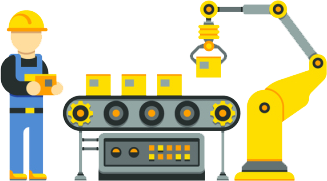Exhaust Gas Filtration and Treatment Equipment for Coating Production Line
Equipment Purpose
-
Exhaust Gas Treatment: During the coating production process, especially in spraying and drying operations, a significant amount of exhaust gas is generated. These gases contain volatile organic compounds (VOCs), particulate matter, and odors. The primary function of this equipment is to filter and treat these harmful gases and particulates, ensuring that emissions meet environmental standards and reduce pollution.
-
Environmental Compliance: With increasingly stringent environmental regulations, coating enterprises must ensure that their exhaust gas emissions comply with national and local environmental laws. This equipment, through its efficient filtration and purification technologies, helps companies achieve green production and avoid penalties for non-compliance.

Equipment Composition
-
Pre-treatment Unit: Typically includes filter cotton and primary filters, which remove large particulate impurities and dust from the exhaust gas. This prevents these impurities from entering subsequent treatment units, thereby maintaining the operational efficiency and service life of the equipment.
-
Adsorption Unit: Activated carbon or other adsorbent materials are used to adsorb organic compounds in the exhaust gas. Activated carbon has a large specific surface area and strong adsorption capacity, effectively capturing VOCs and other harmful gases, reducing the organic content in the exhaust.
-
Catalytic Oxidation Unit (Optional): For exhaust gases that are difficult to treat through adsorption alone, the equipment can be equipped with a catalytic oxidation unit. Under the action of a catalyst, organic compounds in the exhaust gas are oxidized and decomposed into carbon dioxide and water at relatively low temperatures, further purifying the gas.
-
Post-treatment Unit: After adsorption and catalytic oxidation, the exhaust gas may still contain trace pollutants. The post-treatment unit further purifies the gas to ensure compliance with emission standards. Common post-treatment methods include photocatalytic oxidation and biofiltration.
-
Control System: The equipment is equipped with an advanced control system that can monitor parameters such as exhaust gas flow, temperature, and pressure in real-time. It automatically adjusts the equipment's operating conditions based on these parameters to ensure stable and reliable treatment results. The control system also enables remote monitoring and fault alarm functions, facilitating management and maintenance.
Working Principle
-
Exhaust Gas Collection: The exhaust gas generated by the coating production line is collected through a duct system and introduced into the equipment's inlet.
-
Pre-treatment: The exhaust gas first passes through the pre-treatment unit, where large particulate impurities and dust are removed. The preliminarily purified gas then enters the adsorption unit.
-
Adsorption Treatment: In the adsorption unit, the exhaust gas passes through an activated carbon layer or other adsorbent material. Organic compounds are adsorbed onto the surface of the adsorbent, and the purified gas enters the catalytic oxidation unit (if present).
-
Catalytic Oxidation (Optional): For exhaust gases with high concentrations of organic compounds, after entering the catalytic oxidation unit, the organic compounds are oxidized and decomposed into carbon dioxide and water under the action of a catalyst at a lower temperature, further reducing the organic content in the exhaust gas.
-
Post-treatment: The exhaust gas, after adsorption and catalytic oxidation treatment, enters the post-treatment unit for final purification to ensure compliance with emission standards.
-
Emission: The treated exhaust gas is discharged into the atmosphere through a chimney. Meanwhile, the control system continuously monitors the emission conditions to ensure compliance with environmental requirements.
Advantages
-
High Purification Efficiency: Combining multiple purification technologies, the equipment effectively removes harmful substances from the exhaust gas, ensuring compliance with emission standards.
-
Energy-saving and Environmental Protection: During the exhaust gas treatment process, the equipment operates with low energy consumption. Moreover, by converting organic compounds into harmless substances through adsorption and catalytic oxidation, it achieves a circular use of resources, meeting both environmental and energy-saving requirements.
-
High Degree of Automation: Equipped with an advanced control system, the equipment can operate automatically and can be remotely monitored. It is easy to operate, stable, and reliable, reducing management and labor costs for enterprises.
-
Long Service Life: The equipment is made of high-quality materials, with a compact structure and stable performance, ensuring a long service life and low maintenance costs.
Application Fields
-
Automobile Manufacturing: The exhaust gas from automobile coating production lines contains a large amount of organic solvents and particulate matter. This equipment can effectively treat these gases, ensuring compliance with environmental standards for automobile manufacturers.
-
Furniture Manufacturing: The coating process in furniture production also generates exhaust gas. The equipment can be used by furniture enterprises to treat exhaust gases, improving workshop environments and reducing environmental impact.
-
Appliance Manufacturing: Appliance coating production lines similarly require exhaust gas treatment. The equipment meets the needs of appliance enterprises, enhancing their environmental performance.
-
Other Coating Industries: Such as ship coating, steel structure coating, and machinery manufacturing coating industries, this equipment also has a broad application prospect, providing effective solutions for environmental governance in the coating industry.
In summary, the Exhaust Gas Filtration and Treatment Equipment for Coating Production Line is an essential piece of environmental protection equipment, playing a significant role in the sustainable development of the coating industry. By using this equipment, enterprises can not only meet environmental requirements but also improve production environments, enhance their social image, and achieve economic benefits.











